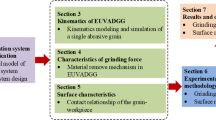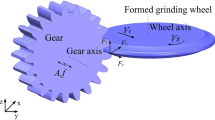Abstract
In order to obtain high-performance gear elements with integrated shape, using non-resonant theory, the gear grinding experiment and ultrasound-assisted grinding acoustic system were established. Firstly, a theoretical model founded on the non-resonant proposed methodology was constructed. The frequency equation and displacement characteristics of the vibration system were established based on the specified boundary conditions, and the geometric size of the ultrasonic amplitude with a design frequency of 20 kHz was established. The acoustic system was simulated employing finite element software, and the analysis revealed that its frequency range was 19648 Hz, which was consistent with the design outcome. Meanwhile, the amplitude of the end surface of the tool gear reaches 5.59 µm, and the vibration was stable. Secondly, according to the solution of geometric parameters, the acoustic performance test was carried out. The error between resonant frequency (20387 Hz) and design frequency was 1.93 %, and the amplitude was 4.5 µm, which met the requirements of ultrasonic assisted grinding gear. Finally, the grinding test was carried out. The study results show that compared to conventional gear grinding, ultrasonic supported grinding lessens the grinding force by 11.5 % to 35.4 % and, at most, lowers the grinding temperature by 22.5 %.
Similar content being viewed by others
Abbreviations
- k :
-
Circular wave number (k = ω/C)
- ω :
-
Circular frequency (ω = 2πf)
- β :
-
Deformation coefficient ((β = r1 − r2) / r1L2)
- f x,f y,f z :
-
Design simulation and experimental frequency
- ς :
-
Density
- μ :
-
Poisson ratio
- a p :
-
Radial feed
- vw :
-
Feed speed
- n:
-
Spindle speed
- E :
-
Elastic modulus
- A :
-
Amplitude
- D, F :
-
Undetermined coefficients
References
G. Venkatesh, A. K. Sharma and P. Kumar, On ultrasonic assisted abrasive flow finishing of bevel gears, Int. J. Mach. Tools Manuf., 89 (2015) 29–38.
B. Karpuschewski, M. Beutner and J. Eckebrecht, Surface integrity aspects in gear manufacturing, Procedia CIRP, 87 (2020) 3–12.
H. Kitzig-Frank, T. Tawakoli and B. Azarhoushang, Material removal mechanism in ultrasonic-assisted grinding of Al2O3 by single-grain scratch test, J. Adv. Manuf. Technol., 91 (2017) 2949–2962.
H. Chen, J. Tang and W. Zhou, An experimental study of the effects of ultrasonic vibration on grinding surface roughness of C45 carbon steel, J. Adv. Manuf. Technol., 68(9–12) (2013) 2095–2098.
T. T. Öpöz and X. Chen, Experimental investigation of material removal mechanism in single grit grinding, Int. J. Mach. Tools Manuf., 63 (2012) 32–40.
J. Kumar, Ulrasonic machining-a comprehensive review, Machining Science and Technology, 17(3) (2013) 325–379.
B. Karpuschewski, H. J. Knoche and M. Hipke, Gear finishing by abrasive processes, CIRP Annals, 57(2) (2008) 621–640.
F. Jiao, Y. Niu and M. J. Zhang, Prediction of machining dimension in laser heating and ultrasonic vibration composite assisted cutting of tungsten carbide, J. Adv. Manuf. Technol., 17(1) (2018) 35–45.
H. Singh and P. K. Jain, Study on ultrasonic-assisted electrochemical honing of bevel gears, Proc. Inst. Mech. Eng. B: J. Eng. Manuf., 232(4) (2018) 705–712.
T. Yu, T. Zhang and X. Yu, Study on optimization of ultrasonic-vibration-assisted polishing process parameters, Measurement, 135 (2019) 651–660.
S. L. Wei, H. Zhao and J. T. Jing, Investigation on surface residual stress distribution and evaluation of engineering ceramics in rotary ultrasonic grinding machining, Proc. Inst. Mech. Eng. C: J. Mech. Eng. Sci., 231(15) (2017) 2773–2782.
Z. C. Yang, L. D. Zhu and G. X. Zhang, Review of ultrasonic vibration-assisted machining in advanced materials, Int. J. Mach. Tools Manuf., 156 (2020) 103594.
H. F. Chen, J. Y. Tang and W. Shao, An investigation on surface functional parameters in ultrasonic-assisted grinding of soft steel, J. Adv. Manuf. Technol., 97 (2018) 2697–2702.
Y. Cao, Y. J. Zhu and H. N. Li, Development and performance of a novel ultrasonic vibration plate sonotrode for grinding, J. Manuf Process, 57 (2020) 174–186.
Y. Wang, S. Geng and Z. Z. Cheng, Experimental study of surface generating process in tangential ultrasonic vibration assisted grinding for titanium alloys, Proc. Inst. Mech. Eng. C: J. Mech. Eng. Sci., 235(19) (2021) 4161–4170.
W. H. Zhou, J. Y. Tang and W. Shao, Modelling of surface texture and parameters matching considering the interaction of multiple rotation cycles in ultrasonic assisted grinding, Int. J. Mech. Sci., 166 (2020) 105246.
B. Y. Wei, X. Z. Deng and Z. D. Fang, Study on ultrasonic-assisted lapping of gears, Int. J. Mach. Tools Manuf., 47(12–13) (2007) 2051–2056.
T. Vu-Huu, P. Phung-Van, H. Nguyen-Xuan and M. Abedl Wahab, A polytree-based adaptive polygonal finite element method for topology optimization of fluid-submerged breakwater interaction, Comput. Math. with Appl., 76(5) (2018) 1198–1218.
T. Vu-Huu, C. Le-Thanh and H. Nguyen-Xuan, Polygonal finite element for two-dimensional lid-driven cavity flow, CMC-Computers Materials and Continua, 70(3) (2022) 4217–4239.
T. Y. Yue and M. A. Wahab, Finite element analysis of fretting wear under variable coefficient of friction and different contact regimes, Tribology International, 107 (2017) 274–282.
H. Tran-Ngoc, S. Khatir and T. Le-Xuan, Finite element model updating of a multispan bridge with a hybrid metaheuristic search algorithm using experimental data from wireless triaxial sensors, Engineering with Computers (2021) 1–19.
A. Hamit, Z. Sağlam and M. Ş. Adin, Numerical investigation of fatigue behavior of non-patched and patched aluminum/composite plates, European Mechanical Science, 5(4) (2021) 168–176.
A. Hamit, B. Yildiz and M. Ş. Adin, Numerical investigation of fatigue behaviors of non-patched and patched aluminum pipes, European Journal of Technique (EJT), 11(1) (2021) 60–65.
B. Zhao, B. X. Chang and X. B. Wang, System design and experimental research on ultrasonic assisted elliptical vibration grinding of Nano-ZrO2 ceramics, Ceram. Int., 45(18) (2019) 24865–24877.
M. Lv, L. Ma and G. X. Liang, Research on design and manufacture of ultrasonic-vibration-based gear-honing device, Key Engineering Materials, 359 (2007) 436–440.
Y. Z. She, M. Lv and S. Y. Wang, Research on dynamic characteristics of gear in ultrasonic gear honing, Applied Mechanics and Materials, 138 (2012) 687–692.
S. Y. Wang, M. Lv and G. Ya, Research on system design of ultrasonic-assisted honing of gears, Advanced Materials Research, 53 (2008) 191–196.
B. Zhao, X. C. Guo and W. B. Bie, Thermo-mechanical coupling effect on surface residual stress during ultrasonic vibration-assisted forming grinding gear, Journal of Manufacturing Processes, 59 (2020) 19–32.
Z. M. Lin, Principle and Design of Ultrasonic Horn, Science Press, Beijing (1987).
Acknowledgments
This work is supported by the National Natural Science Foundation of China (No.52005164 and No.51875179).
Author information
Authors and Affiliations
Corresponding author
Additional information
Xiao-bo Wang is a doctor of Precision and Special Machining Technology and Equipment Laboratory of Henan Polytechnic University, mainly engaged in the research of precision and ultra-precision machining technology and equipment.
Ming-qiang Wu is a postgraduate student of Precision and Special Machining Technology and Equipment Laboratory of Henan Polytechnic University. His research direction is precision and ultra-precision machining technology and equipment.
Jiang-wei Jin is a postgraduate student of Precision and Special Machining Technology and Equipment Laboratory of Henan Polytechnic University. His research direction is precision and ultra-precision machining technology and equipment.
Bo Zhao is a Professor of Precision and Special Machining Technology and Equipment Laboratory of Henan Polytechnic University, mainly engaged in the research work of advanced manufacturing technology, theory and equipment of precision machining of hard and brittle materials.
Rights and permissions
About this article
Cite this article
Wang, X., Wu, M., Jin, J. et al. Acoustic system design and experimental research on the ultrasonic forming grinding gear. J Mech Sci Technol 37, 3975–3983 (2023). https://doi.org/10.1007/s12206-023-0714-0
Received:
Revised:
Accepted:
Published:
Issue Date:
DOI: https://doi.org/10.1007/s12206-023-0714-0




